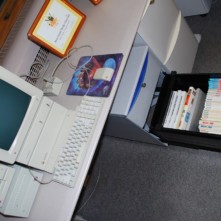SimCity at GDC
| March 14th, 2011 11:56 AM by Ken Gagne | Filed under Mainstream coverage, Software showcase; Comments Off on SimCity at GDC |
Juiced.GS associate editor Andy Molloy and I are exhausted from a weekend spent at PAX East, an annual video game convention held in Boston. There were some fun classic computer references: Bill Amend put up a picture of an old, non-Apple II computer as representative of the state of technology when he started drawing FoxTrot; Paul Saunders of LoadingReadyRun and The Escapist cited Hard Hat Mack as one of his first and favorite games as a kid (he can expect an issue of Juiced.GS in his mailbox later this month), while his colleague Graham Stark acknowledged The Interbank Incident; and Jerry Holkins reminisced about thinking for a week that he’d lost his Wasteland save game before realizing it was on the other side of the floppy. He actually hugged his mom, crying, “We’re back!”
For gamers, there were several classic arcade and console rooms, the former courtesy the American Classic Arcade Museum to which Andy and I made our annual pilgrimage last month, but other than the aforementioned hat tips, there wasn’t much here for retrocomputing enthusiasts. Such was not the case at the Game Developers Conference earlier this month, where an iOS version of Out of This World was announced. But there was some other insight out of GDC of interest to Apple II users.
A popular form of GDC panel is the post-mortem, in which developers talk about the thought and processes that went into a game that was released anywhere from a day to a decade ago. Will Wright of SimCity fame was one such presenter, discussing the origin of Raid on Bungeling Bay:
When he decided to make a game after learning BASIC and Pascal, “It was almost more of a whim,” he said. At that point, a lot of people on the Apple II were on their second or third generation games, so he was worried about competing with them.
But the Commodore 64 had just come out, “so I thought I’ll just buy one of these new computers, make a game on that, and level the playing field,” said Wright. He actually programmed the game on the Apple II, then dumped it onto the C64.
“I remember I was 4 or 5 years old, and I went on a helicopter ride, and it was one of the coolest things in the world,” he said, so he knew he wanted helicopters in the game, as well as some sort of clockwork world. And since the Apple II’s games were all very simple screens, “I wanted a very large world that I could really get lost in, and feel like it was that large.”
He made two tools to build the game world: Chedid was a character editor, which was “really primitive,” he said. Wedit lets you scroll around the world and place the characters from Chedid. “Wedit eventually evolved into Sim City,” he said. “I was scrolling around the world and having a lot of fun with it.”
So, there you have it: SimCity was designed to be a map editor for an Apple II game. How frustrating that the Apple II’s role in the creation of one of gaming’s most celebrated franchises has not been rewarded with its own version of SimCity. With the source code having been made available some years ago, shouldn’t it just be a matter of time? It’s a popular topic in csa2, but AFAIK, the only attempts to port the game were made before the source was released. How about a renewed effort?
UPDATE: The video, audio, and slides from this GDC presentation are now available.
(Hat tip to Jason Scott)









